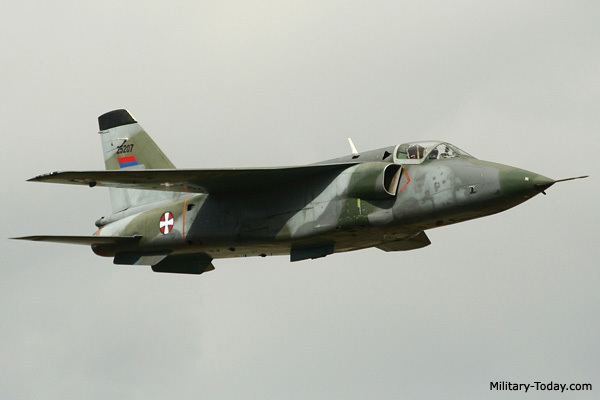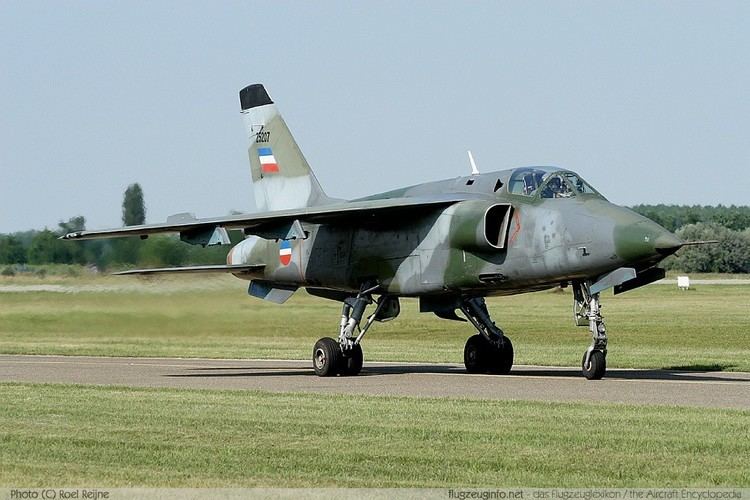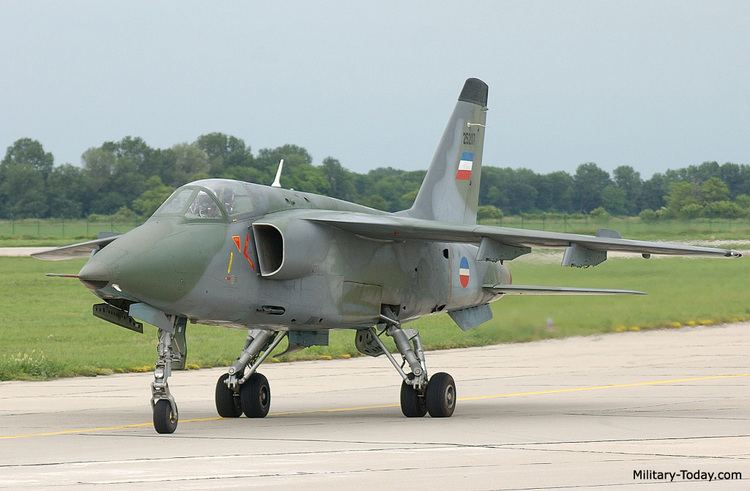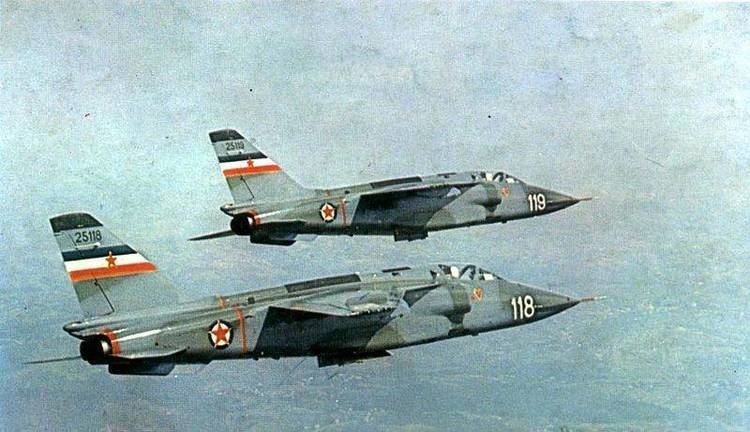Top speed 1,130 km/h Length 13 m Engine type Armstrong Siddeley Viper | Wingspan 9.3 m Introduced 1978 First flight November 1976 | |
 | ||
The Soko J-22 Orao (English: Eagle) is a Yugoslav twin-engined, subsonic ground-attack and reconnaissance aircraft. It was designed as a single-seat main attack version or as a combat capable two-seat version for advanced flying and weapon training. It was developed as a joint Yugoslav-Romanian project in the 1970s for the air forces of both nations, SOKO built it in Yugoslavia, and Avioane Craiova built it as the IAR-93 Vultur in Romania.
Contents
- Soko j 22 orao strike fighter aircraft serbian air force
- Development
- Design
- Operational history
- Variants
- Operators
- Specifications J 22
- References

Soko j 22 orao strike fighter aircraft serbian air force
Development

On 20 May 1971, the governments of Romania and Yugoslavia signed an agreement for the formation of YuRom, a joint R&D venture. The program was headed by Dipl. Dr. Engineer Teodor Zanfirescu of Romania and Colonel Vidoje Knezević of Yugoslavia. The aircraft was intended as a replacement for the lightly armed Soko J-21 Jastreb and the Republic F-84 Thunderjet, then in the JNA arsenal.

The requirements called for a light aircraft to be built on a simple structure, using locally produced equipment and avionics, tough (able to operate on grass or damaged runways), easy to maintain and reliable. The aircraft was of conventional twin-engine, high mounted wing monoplane configuration with all flying surfaces swept. The designers originally planned a single-engined supersonic aircraft, but Britain would not authorize the license for the engine the designers wanted (due to Romania being in the Warsaw Pact), so the less-powerful Rolls-Royce Viper was chosen as the powerplant, as Soko had experience with license-building this engine. It was originally intended that an afterburner would be developed for the Viper engines, but there were prolonged difficulties with this project, meaning that none of the pre-production aircraft featured it, and neither did early production examples. During the 1980s, both countries developed slightly different versions to take advantage of the afterburning engines that had since become available.

The Yugoslav prototype 25002 made its first flight in November 1974 from Batajnica Air Base near Belgrade, with Major Vladislav Slavujević at the controls.

The third aircraft, numbered 003, a pre-production two-seater version, made its first flight on 4 July 1977, but was lost almost a year later due to tail flutter problems. Construction continued, and the first batches of pre-production machines were delivered in 1978 to the Air Force Aircraft Testing Facility in Belgrade, with serial production being set up in Mostar, Bosnia and Herzegovina.

On 22 November 1984, Orao 25101 piloted by test pilot Marjan Jelen broke the sound barrier in a shallow dive over Batajnica Air Base, becoming the first Yugoslav-designed aircraft to exceed Mach 1. The aircraft is incapable of breaking the sound barrier in level flight, so it is classified as subsonic.
Design
The J-22 is a twin-engined combat jet aircraft for close air support, ground attack and tactical reconnaissance warplane with limited air-defense capability.
Standard communication and navigation equipment, plus (fire control and weapons management) Thompson-CSF VE-120T HUD replacing the original Ferranti ISIS D-282 gyro sight (defensive sensors and systems) Iskra SO-1 RWR and provision for up to three chaff/flare dispensers and P10-65-13 passive jammer pod, and (navigation) Honeywell SGP500 twin-gyro platform; there is also provision for an optical/IR reconnaissance pod or an optical reconnaissance/jammer pod.
Operational history
The first Yugoslav Air Force unit which received J-22 aircraft was the 351st (reconnaissance aviation squadron) from 82nd Aviation Brigade, Cerklje. Until the 1991 war, there were only three squadrons fully equipped with J-22 attack aircraft and NJ-22 trainer-attack aircraft. Those units were the 238th (fighter-bomber aviation squadron) from 82nd Aviation Brigade, 241st and 98nd Aviation Brigade and 242nd and 127th Fighter-Bomber Regiment, Golubovci Airbase. There were also about three squadrons partly equipped with J-22 aircraft.
At the beginning of the Yugoslav wars, in Slovenia, J-22s flew over in a show of force, but did not drop any bombs. The first offensive action by the J-22 was in 1991 when the Yugoslav National Army used them to strike targets in Croatia. During the first year of war three J-22s were shot down, NJ-22 flown by Lieutenant Colonel Muse Begić who ejected safely and a J-22 flown by Major Z.Tomić (KIA) from the 238th. After the withdrawal of the JNA from Slovenia, the 82nd Aviation Brigade was relocated from Cerklje to Banja Luka Mahovljani air base. In 1992 when the Bosnian war started, the JNA left a single squadron of eight J-22s to the Republika Srpska Air Force. One J-22 was lost during the war.
In 1999, Yugoslav J-22s saw limited combat against the KLA flying 20 combat missions. One J-22, piloted by Lt. Colonel Života Ðurić was lost on 25 March 1999 in unclear circumstances, either through malfunction, pilot error or KLA ground fire. In addition, 11 aircraft were destroyed on the ground, most at Ponikve airbase when a NATO air strike hit one hangar with six J-22 and two MiG-21 aircraft.
On June 3, 2010, a Serbian Air Force J-22, piloted by Major Slobodan Jocić, crashed in central Serbia. The aircraft's landing gear malfunctioned, forcing the pilot to direct the aircraft into a lake and eject. The pilot was safely rescued soon after the incident.
Variants
Operators
Specifications (J-22)
Data from Jane's All The World's Aircraft 1993-94
General characteristics
Performance
Armament
